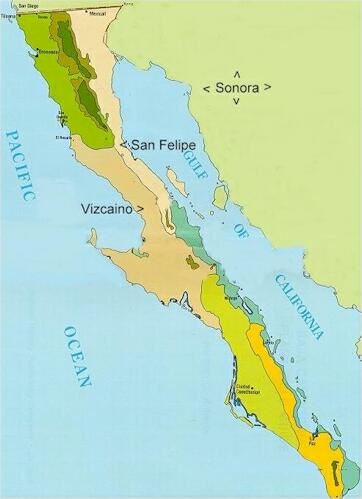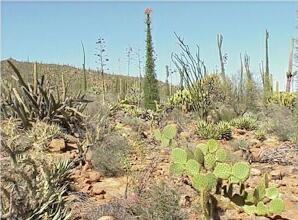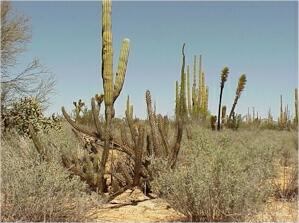BAJA CALIFORNIA DESERTS The Baja California peninsula of Mexico is a long finger of land about 150 km wide and extending 1,300 km south from the border with California in the USA to the Tropic of Cancer near its southern tip. For most of its length this peninsula is separated from mainland Mexico (the province of Sonora) by the Gulf of California (also known as the Sea of Cortex). Several mountain ranges form a backbone to Baja California, so that the land rises from sea level on the west (Pacific) coast to elevations ranging from about 1200 to 3000 metres, before dropping again towards the Gulf of California. As shown below, two major desert regions occur in northern and central parts of this peninsula:
Vizcaino Desert
The deserts of Baja California are further south than those of the USA, with a milder, subtropical climate where frosts seldom occur at the lower elevations. Coupled with this, the westerly winds carry moisture-laden air (sea fogs) from the Pacific, leading to an astonishingly rich and diverse vegetation in parts of the Vizcaino desert region. The vegetation here includes many large cacti, such as cardon, barrel cacti, candelabra cactus, senita, sour pitaya, velvet cactus and chain link cholla, and other stem or leaf succulents such as boojum, elephant trees and agaves. There are also many frost-sensitive desert shrubs such as slipper plant, a distinctive yucca (datilillo) and epiphytes (ball moss) and parasites (dodder) that flourish where in the moisture-laden air. San Felipe Desert The San Felipe Desert lies near the eastern side of the Baja California peninsula, in the "rain shadow" of the mountains, so it is an extremely arid desert. Nevertheless, it contains Sonoran desert plants that are not found in the USA, including relatives of the common ocotillo, such as Adam's tree, and several types of elephant tree. Nearly 700 plant species in Baja California are endemic - being found only in this region. One such example is the blue fan palm, found on desert slopes and flats near major water courses.
|
||||||||||






